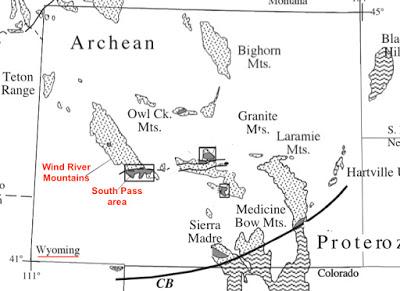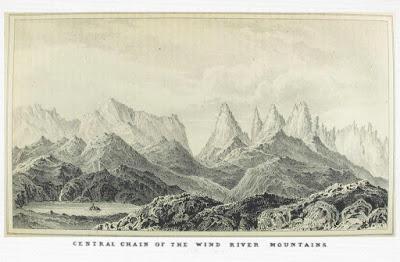
I spent last week on the southern edge of North America. But I wasn’t surfing or beach-combing or sipping margaritas on white sand by a sparkling blue-green sea. Instead, I wandered in bright sunlight and incessant wind around ancient rocks standing above rolling sagebrush-grasslands.

The hunt is on.
More precisely, I was on what once was the southern margin of North America, about 2.5 billion years ago. That was near the end of the Archean Eon, back when the Earth was still a young planet busily creating, expanding, and aggregating its continents.Fast-forward two billion years, by which time North America was shaped pretty much as it is today. The continental interior was undergoing 30 million years of major deformation, called the Laramide Orogeny. The Rocky Mountains were uplifted, including most mountain ranges in Wyoming.

Laramide mountain ranges in Wyoming. Stippling indicates exposed Archean rock. After Frost et al. 2006.
The Wind River Mountains in western Wyoming are an exemplary Laramide-style uplift, with sloping sedimentary strata on the northeast side and a steep reverse fault on the southwest. Critical to this story, previously-buried ancient Archean rocks were lifted high, and are now exposed over an area of more than 10,000 sq km and to 4000 m elevation (13,804 feet at Gannett Peak).
“The scenery becomes hourly more interesting and grand, and the view here is truly magnificent; but, indeed, it needs something to repay the long prairie journey of a thousand miles. The sun has just shot above the wall, and makes a magical change. The whole valley is glowing and bright, and all the mountain peaks are gleaming like silver.” (illustrations from Fremont 1845)
“Though these snow mountains are not the Alps, they have their own character of grandeur and magnificence, and will doubtless find pens and pencils to do them justice.” — Capt. JC Fremont
 In 1842, Brevet Captain John C. Fremont led his Exploring Expedition to the Rocky Mountains through the southernmost part of the Wind River Range. He had heard it was an easy way to cross the Continental Divide, with plenty of good water (not alkaline). They traveled west up the Sweetwater River to South Pass, and found the grades were indeed gradual—so much so that he had to look carefully to find the actual divide.
In 1842, Brevet Captain John C. Fremont led his Exploring Expedition to the Rocky Mountains through the southernmost part of the Wind River Range. He had heard it was an easy way to cross the Continental Divide, with plenty of good water (not alkaline). They traveled west up the Sweetwater River to South Pass, and found the grades were indeed gradual—so much so that he had to look carefully to find the actual divide.“… the traveler, without being reminded of any change by toilsome ascents, suddenly finds himself on the waters which flow to the Pacific ocean. … I should compare the elevation which we surmounted immediately at the Pass, to the ascent of the Capitol hill from the avenue, at Washington [DC].”Fremont's encouraging description of South Pass helped launch the great westward migration of the mid-1800s. Over the next twenty years, several hundred thousand hopeful souls crossed South Pass, bound for promised lands in Utah, Oregon and California.

Concrete posts now mark the Oregon–Mormon–California trail. South Pass is left of center.

Not many travelers on the Oregon Trail these days.
In his expedition report (1845), Fremont mentioned curious granite outcrops in the vicinity of South Pass:“At a distance, the granite frequently has the appearance of irregular lumps of clay, hardened by exposure.”

In 1870, geologist Ferdinand Vandeveer Hayden, head of the US Geological Survey of the Territories, took his expedition through the South Pass area. By this time there were towns—South Pass City, Atlantic City, and Miners Delight. All had sprung up just a few years earlier with the rush for gold. Hayden reported that the area showed great promise:
“The portion in which the South Pass is located is about ten miles wide, and is composed mostly of metamorphic slates in a nearly or quite vertical position. It is in these slates that the gold mines are found. The gulch diggings are quite extensive, and although much has been done in that way, yet there is a most extended field open yet for the enterprising miner or laborer. … It will be seen at once that the great value of these ores lies in the ease with which the gold can be extracted.”The South Pass area would host the biggest gold rush in Wyoming, but would not live up to Hayden’s great expectations.
Pioneering photographer William Henry Jackson traveled with Hayden. He took this photograph of South Pass City from today’s Jackson Point, accessible by a short trail. The outcrop in the foreground is made of Hayden’s “metamorphic slates”—now classified as Archean metagraywacke (slightly metamorphosed graywacke) and graywacke schist of the Miners Delight Formation (Hausel and Love 1992).

South Pass City in 1870.

South Pass City today—restored, and a State Historical Site.
The party continued west to South Pass, where Hayden noted the curious granite outcrops mentioned 28 years earlier by Fremont:
“Near the crossing of the Sweetwater are thick beds of reddish feldspar and white quartz imbedded with the gneiss. The white quartz extends across the country in bands, about northeast and southwest. The quartz seams in the massive granites are quite conspicuous, and trend in the same direction.”

Quartz in foreground; another granite outcrop mid-photo. Looking southwest.
Hayden lamented his too-short stay in the Wind River Mountains, and hoped to return for further study. But he never did, and perhaps it was just as well.“Although, the geology as well as the mineralogy of the Wind River range is very simple, yet we turned our backs upon it with regret.” (italics added)Hayden was wrong. While the range may be a straight-forward example of Laramide-style mountain-building, the great mass of exposed Archean rocks are not at all simple. They came to be in the far distant past, starting maybe 3.2 billion years ago, and have been greatly modified by subsequent events. They’re a tough read, and geologists struggle to explain how they came to be.

High peaks of the Wind River Mountains in the distance, still snow-covered in mid-June.
Some geologists think that in late Archean time the South Pass region was an area of continental growth. Fragments of crust (terranes) and strings of islands collided with and were amalgamated to the Wyoming Craton, a small continent that would go on to become part of North America. But others think the Earth’s crust was still too young and hot for plate tectonics—pointing out Archean rocks with no modern analogues (e.g. Hamilton 1998).At 2.5 billion years old, Fremont’s “irregular lumps” of granite in the South Pass area are among the youngest Archean rocks in the Wind River Mountains. They were intruded on the southern margin of the Wyoming Craton near the end of the Archean, when the craton was about to coalesce with its brethren to form the supercontinent Kenorland (source). The granite crops out sporadically, rising above rolling terrain developed on much younger sedimentary rocks.

Late Archean granite rises above the Miocene Split Rock Formation, only 16-17 million years old (source).
To walk around this ancient granite, dating back to when continents were mere infants, is my kind of spiritual experience. It was made even more powerful by the thousands of ghostly travelers passing by, in wagons and on foot, with a thousand miles behind them and a thousand more to go. And it was an unexpected treat, for I hadn't come here to commune with the past. I was searching for rare plants …
(to be continued)

South Pass granite, with the Oregon Buttes on the far horizon. For most immigrants, the buttes marked the halfway point on their journey west.
SourcesFremont, JC. 1845. Report of the Exploring Expedition to the Rocky Mountains in the year 1842, and to Oregon and North California in the years 1843-44. Washington: Gales and Seton, Printers.Frost, BR, et al. 2010. Late Archean structural and metamorphic history of the Wind River Range: Evidence for a long-lived active margin on the Archean Wyoming craton. GSA Bull. 112:564-578.
Frost, CD, et al. 2006. Archean crustal growth by lateral accretion of juvenile supracrustal belts in the south-central Wyoming Province. Can. J. Earth Sci. 43:1533-1555.
Hausel, WD, and Love, JD. 1992. Field guide to the geology and mineralization of the South Pass region, Wind River Range, Wyoming (42nd Field Conference, 1991). Laramie: Wyoming Geological Association.
Hayden, FV. 1871. Preliminary report of the United States Geological Survey of Wyoming and of contiguous territories. Washington: Government Printing Office.
